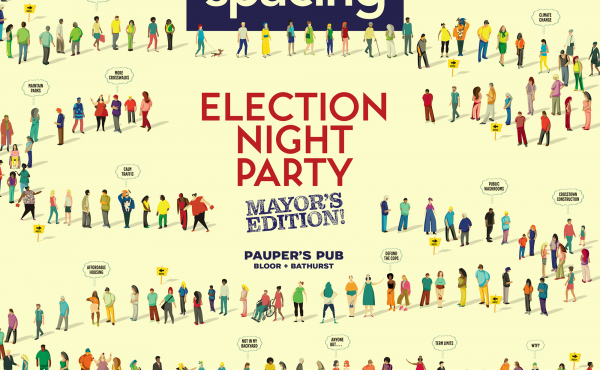
Today’s Toronto Star has a great section called “What If?” It is very much like our “History of our Future” issue from last summer. I’m not saying that just to toot our own horn — a number of Star writers contacted Spacing contributors and editors to help shape this section. There are two stories that focus on the same topics and people that appeared in that issue: a feature on Velo-City, the elevated bike network stretching out across the city by Chris Hardwicke (a Spacing Wire contirbutor), and Graham Lee’s idea about turning the SkyDome into a new housing community. Also featured is what Toronto’s subway system could look like if we had started to build the network in the early 1900s (the article has quotes from both myself and Spacing Wire contirbutor James Bow of Transit Toronto).
Chris Hutsul, also a Spacing contributor and regular Star columnist, wants the city to legalize graffiti and encourage us to use the city as a canvas. Christopher Hume talks about elevating the architectural quality in the city, and there’s a great piece about building business communities around GO stations.
I know I spent a few moments the other night dreaming about what I would do if I won $20 million in the Super7 lottery (I didn’t win sadly, but I was really confident I would). It seems Mayor Miller also stays awake at night dreaming about Toronto’s possibilities.
Too often the people of this city complain and whine about present day concerns with little eye to the future. It is very nice to see the Star do some forward thinking because it inspires us to imagine. And possibly strive to turn this city into something even more meaningful than it already is.




8 comments
I loved these articles, especially Miller’s, they really made my morning!
I do like the idea of a Copenhagen-like cycling lane system more than velo-city, though; the latter reminds me of the skywalks that have emptied downtowns in the US because they never require you to be on the ground level.
What if everyone in the GTA had a dream subway map printed on a glossy, 3″x5″ postcard (with the obligatory THIS IS NOT REAL – BUT IT COULD BE) message on it? Maybe they would demand it.
I like this section a lot 🙂
I’m not a big fan of graffiti, and many, many others are not. If you want to bring art to more people, try using something that they actually find artistic. You start with (or even try likely) to spread more graffiti around in the name of art, and you’ll just turn the marginal supporters off the whole art for the masses thing.
In 1980 I moved with my family to a new subdivision in Markham. The fences for the backyards hadn’t been built yet, and the 12 houses that all backed onto the same green space as us shared a giant backyard. Us, along with our neighbours would have BBQs together and share the same play equipment. We soon built fences, and this sense of community was lost.
Recently I’ve been thinking it would be nice to have groups of houses that all share the same fences to tear them down and then share the same giant backyard – share BBQs, picnic tables, swings, pools etc. and basically interact more with their immediate neighbours. Perhaps also new subdivisions could be built with this in mind. Some housing co-ops and townhouses already exist in a similar way to this. It would be nice to see it wide spread.
I think one of the reasons why you think graffiti will turn people off is because there is so many bad examples and innappropriately placed stuff around. All the tagging gets confused with graffiti art, and since it’s everywhere and useless, it seems like a bad idea.
Also, there’s a lot of just bad graffiti, made by people with little talent. Since there is no system in place that regulates if something is “good” (as problematic as that word may be) anybody with a can of paint can do whatever they want wherever. So we get a lot of crappy bad art.
Imagine if all those crappy rock bands practicing in suburban garages suddenly could get gigs at will at say, Lee’s Palace, and that bad awful stuff became the public face of rock and roll. People would turn sour on it quickly.
So the problem and good thing about grafitti is that there are no rules but that it’s also sort of rebelious and rule breaking at the same time.
I really like the concept of the GO transit “cities.” When I see commuter trains in other cities around the world, and see how they are used both ways the entire day, it amazes me that we don’t.
The dream subway map, while nice to think about, is probably unrealistic and overkill. I like what Mayor Miller said in his piece, “There’s a network of streetcars crossing this city on reserved rights-of-way. The Finch Hydro Corridor is now a conduit for light rail transit. People can get from eastern Scarborough to western Etobicoke quickly and at reasonable cost.”
That’s where I think we should be heading. Other than King or Queen Streets, in general all the “Avenues” identified in the cities growth plans are wide boulevards that could handle 2 lanes of traffic in each direction with a ROW and parking. Some teardown of close to the street buildings would be required, but generally those buildings will have to go to meet the density demands of the future anyway.
I was walking along Eglinton from Yonge to Don Mills this weekend, and thinking about how it would be very interesting to see trams running along the street. Perhaps, I thought, we could make Eglinton from Dufferin to Leslie a one way street with 3 lanes of traffic, 1 lane of parking, a bike lane and a lane of transit going in the opposing direction. Then we could build a parallel street heading the other way just north of Eglinton. In between the two streets, and on either side of the streets, high density buildings with lots of street level retail. I think it could be a very pretty pair of streets.
related to the good graffiti art vs. ugly tags discussion. I have the similar issue about “native plant gardens”. many/most native plant gardens that are planted are planted with the understanding that because these are native plants they don’t require any maintenance. while this might be true if they were being planted in the habitat they are native to. I think we can safely say that “native plants” are not native to urban areas (i.e. they did not evolve under urban conditions). what this means is they generally get over run by urban weeds that come from a variety of places including asia and europe, but rarely from ontario… and I could go into a big rant about why that is, but lets just leave it at native plant garden = giant weed patch in most cases. this does not do much for marketing the image of native plant gardens does it?
p.s. I’m all for more graffiti art/murals in this city.
Yes, graffiti friendly policies are what this city needs. I remember how awesome NYC was in the late 70s when it was a graffiti friendly city. Just so much vitality. Plus all the bourgeois were scared off the streets and the proletariat owned the city, taking what they needed form whoever had it. It was paradise.
In other words, show up at my house or business with a can of spraypaint, and you better hope that your life insurance is paid up. After I’m done with you, I’m going to go to your house and that of your parents and do an homage to Tom Green’s porn mobile. It’s good cause it’s art, right?
Making graffiti legal? Thats some bullshit. Vandals should just take their space. Not have it givin to them.
Dont like billboards or grey walls. Paint over them. When it gets buffed do it again……and again and again.
Its fun.